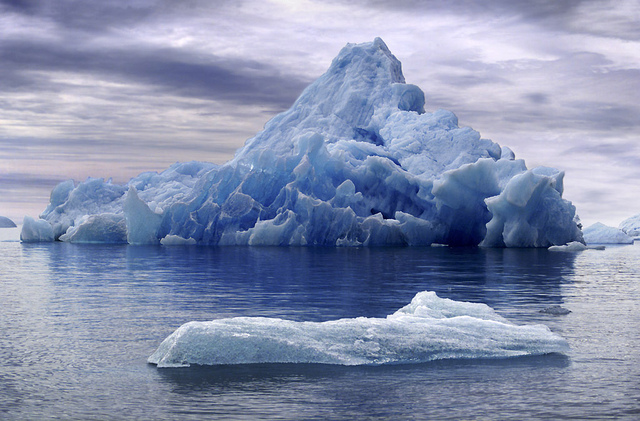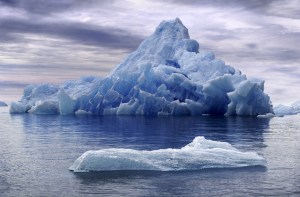Cross-posted from Climate Progress.
One century ago this weekend, the great “unsinkable” ship ignored warnings of icebergs in the vicinity, maintained a high speed, hit an iceberg because it couldn’t change course fast enough, and sank. Most passengers died, in large part because there weren’t enough lifeboats.
The New Yorker and the Washington Post have devoted major columns to why “we can’t let go of the Titanic” and why “fascination with it seems to be” unsinkable.
Director James Cameron offered his own answer this week, in Titanic: The Final Word with James Cameron on National Geographic Channel, which I’ve transcribed here. Cameron, who has also released a 3-D version of his epic blockbuster movie on the doomed ship, made the connection between what happened on the Titanic and our climate predicament:
Part of the Titanic parable is of arrogance, of hubris, of the sense that we’re too big to fail. Well, where have we heard that one before?
There was this big machine, this human system, that was pushing forward with so much momentum that it couldn’t turn, it couldn’t stop in time to avert a disaster. And that’s what we have right now.
Within that human system on board that ship, if you want to make it a microcosm of the world, you have different classes, you’ve got first class, second class, third class. In our world right now you’ve got developed nations, undeveloped nations.
You’ve got the starving millions who are going to be the ones most affected by the next iceberg that we hit, which is going to be climate change. We can see that iceberg ahead of us right now, but we can’t turn.
We can’t turn because of the momentum of the system, the political momentum, the business momentum. There are too many people making money out of the system, the way the system works right now, and those people frankly have their hands on the levers of power and aren’t ready to let ’em go.
Until they do, we will not be able to turn to miss that iceberg, and we’re going to hit it, and when we hit it, the rich are still going to be able to get their access to food, to arable land, to water, and so on. It’s going to be the poor, it’s going to be the steerage that are going to be impacted. It’s the same with the Titanic.
I think that’s why this story will always fascinate people. Because it’s a perfect little encapsulation of the world, and all social spectra, but until our lives are really put at risk, the moment of truth, we don’t know what we would do. And that’s my final word.
If we don’t act soon, the latest science suggests that few will escape the dire consequences, but certainly the poorest will suffer the most and the very rich will be able to insulate themselves, at least for a while.
For the record, as the Washington Post points out, “First-class men, though collectively glorified for letting steerage women and children go first in the lifeboats, actually survived at a higher rate than the third-class children.”
Stephen Cox, a literature professor at the University of California-San Diego, and author of The Titanic Story: Hard Choices, Dangerous Decisions, tells the Washington Post, “I don’t think a myth can develop unless you have a choice that could be very unfortunate or tragic.” In the case of the Titanic, lots of tragic choices were made, including the decision to steam ahead at high speed in the face of iceberg warnings serious enough to cause other ships, like the Californian, to stop completely that night.
The tragedy today is not merely that we are ignoring multiple, highly credible warnings of disaster if we stay on our current course. The tragedy is that the cost of action is so low — one-tenth of a penny on the dollar, not counting co-benefits — while the cost of inaction is nearly incalculable, hundreds of trillions of dollars.
The International Energy Agency warned last November that on our current path, “rising fossil energy use will lead to irreversible and potentially catastrophic climate change” — warming of an almost unthinkable 6 degrees C — whereas “delaying action is a false economy: For every $1 of investment in cleaner technology that is avoided in the power sector before 2020, an additional $4.30 would need to be spent after 2020 to compensate for the increased emissions.”
Cameron is hardly the first person to compare our current predicament with the Titanic. In fact, three years ago, Newsweek’s Evan Thomas used the metaphor, unintentionally offering one explanation for why the “status quo” establishment media’s coverage of global warming is so fatefully inadequate.
Certainly media coverage of the problem and the solution has been poor. But why?
In a March 2009 cover story, Thomas provided the answer — the shocking, unstated truth about the media elite: They have “a vested interest in keeping things pretty much the way they are.”
Assuming we don’t spend the mere 0.11 percent of GDP per year needed to avert catastrophe, future generations who are puzzled about our fatal myopia need look no further for explanation than Thomas’ full remarks. He begins with the amazing admission, “If you are of the establishment persuasion (and I am),” and continues with words that should be emblazoned across journalism schools around the country and read out loud at every Ivy league college graduation:
By definition, establishments believe in propping up the existing order. Members of the ruling class have a vested interest in keeping things pretty much the way they are. Safeguarding the status quo, protecting traditional institutions, can be healthy and useful, stabilizing and reassuring. But sometimes, beneath the pleasant murmur and tinkle of cocktails, the old guard cannot hear the sound of ice cracking. The in-crowd of any age can be deceived by self-confidence …
Thomas was writing about the current economic crisis, but his words apply far better to the global Ponzi scheme. Indeed, his use of the Titanic metaphor could not more ironically apply to the catastrophic global warming that he and his establishment buddies are all but blind to:
… the old guard cannot hear the sound of ice cracking.
This might just be an epitaph for modern human civilization. The latest science makes clear that unless we sharply change course very soon, we may be irreversibly headed toward an ice-free hothouse planet with a carrying capacity far below 9 billion people.
Finally, there’s one last amazing and relevant piece of the Titanic story that must be mentioned — the disaster was “predicted” 14 years in advance. I first heard about this back in college, because one of my dorm mates was a huge Titanic buff. And I was reminded of it reading the New Yorker piece:
The Titanic took two hours and 40 minutes to founder after hitting the berg — which is to say, about the time it takes for a big blockbuster to tell a story.
Tragic déjà vu, classic themes, perfect structure, flawless timing: if you’d made the Titanic up, it couldn’t get any better. But someone did make it up. Perhaps the most unsettling item in the immense inventory of Titanic trivia is a novel called Futility, by an American writer named Morgan Robertson. It begins with a great ocean liner of innovative triple-screw design, “the largest craft afloat and the greatest of the works of men … Unsinkable — indestructible.” Speeding along in dangerous conditions, the ship first hits something on its starboard side (“A slight jar shook the forward end”); later on, there is a terrifying cry of “Ice ahead,” and the vessel collides with an iceberg and goes down.
As the title suggests, the themes of this work of fiction are the old ones: the vanity of human striving, divine punishment for overweening confidence in our technological achievement …
Robertson published his book in 1898, 14 years before the Titanic sailed. If she continues to haunt our imagination, it’s because we were dreaming her long before the fresh spring afternoon when she turned her bows westward and, for the first time, headed toward the open sea.
Surprisingly, the New Yorker omits the full title of the 1898 book — Futility, or the Wreck of the Titan. Yes, the ship was named the Titan. And it had a shortage of lifeboats, and more than half the 2,500 passengers died (compared to more than half of the Titanic’s 2,200 passengers dying).
In the case of climate change, it’s not a fictional novel that is predicting what will happen, it is science. Full steam ahead.





